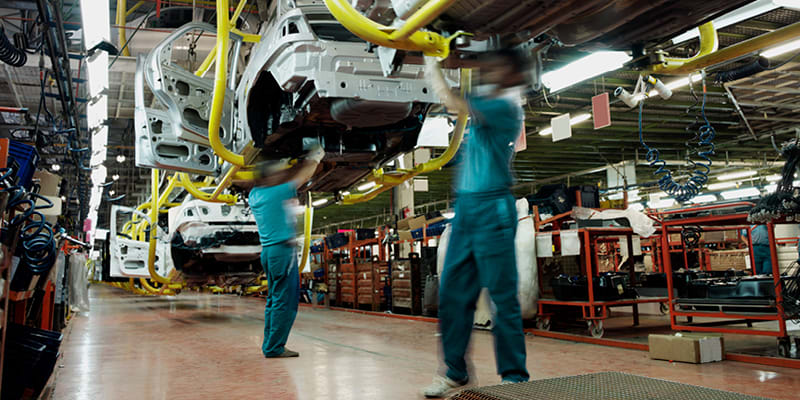Hazardous energy identified as top risk in automotive manufacturing

Ontario’s automotive and light duty vehicle manufacturing sector is a major contributor to Ontario’s economy, employing more than 155,000 people. It includes the manufacturing of cars, trucks, and coaches for personal, commercial, and military use, along with parts suppliers. It also has the third highest subsector risk rating among the sectors WSPS serves, which is why it is the latest sector to undergo an integrated risk assessment workshop with WSPS. Inadequate control of hazardous energy during routine operations was identified as the top risk affecting the industry across the board.
Several sectors, including healthcare, mining, transportation, construction, and agriculture have used the Ministry of Labour, Immigration, Training and Skills Development (MLITSD)’s risk-based approach and proven methodology to focus their prevention efforts. Most recently, WSPS facilitated this process with Ontario’s food and beverage wholesale distribution sector and uncovered its top risks and the root causes for the number one risk.
Bringing together diverse industry voices
“The automotive manufacturing industry in Ontario is fast-paced, dynamic, and demanding. It is also considered high risk for injury and illness,” says Rishma Brenner, Senior Health and Safety Consultant with WSPS. Rishma facilitated the automotive manufacturing risk assessment workshop that took place in May 2024. Workers, supervisors, and management representatives came together to discuss the hazards they view as most prevalent. “It’s important to hear what the industry as a whole is experiencing,” says Rishma. “It’s also important to give workers a voice because they bring a front-line perspective to the process and may feel like their unique insights aren’t always heard.”
“Including representatives from multiple facets of the automotive sector in this process is vital because it helps to highlight our common risks,” says Steve Brennan, Health, Safety, and Ergo Representative from General Dynamics Land Systems. Steve participated in the workshop as a worker representative. “Despite the differences in size and type of company, we collaboratively worked together to understand each other’s concerns,” says Steve.
Micheal Williams, Health, Safety, and Environment Manager at THK Rhythm Automotive, welcomed the opportunity to participate in this workshop. “I value this approach to risk assessment because it involves management and worker representatives from a great range of automotive manufacturing,” says Michael. “When it comes to safety, it’s better to work together.”
Consensus on the top ten risks
Before the day of the workshop, each participant was asked to provide a list of hazards based on what they have personally experienced at work. “This pre-work was great because it put us in the right mindset for the workshop,” says Michael. As the facilitator, Rishma combined the submissions from each participant to create a master list that included 54 hazardous events.
Through active discussion during the workshop, some hazards were removed, some were combined due to similarity, and some new hazards were added. In the end, the group had 45 hazardous events to assess based on likelihood and consequence. “Despite the wide range of businesses represented at the workshop, the top ten risks were applicable to all of us,” says Steve.
After the assessment was complete, inadequate control of hazardous energy during routine operations was identified as the top risk. Noise exposure was second, musculoskeletal disorders were third, and psychologically unsafe workplaces resulting in mental harm was ranked fourth. “The fact that noise was in the top five surprised me a little bit,” says Michael. “However, it makes sense given the high frequency of noise exposure in our work and the fact that it can lead to permanent hearing loss. That’s a severe outcome.”
The top ten list rounds out with mobile equipment operation and pedestrian contact with mobile equipment, ineffective contractor management, exposure to hazardous energy during maintenance, getting struck by or caught in a press, and poor housekeeping leading to slips and trips. This free downloadable infographic provides a visual representation of the top ten risks for easy access.
Next step is root-cause analysis
Now that the risk assessment has been completed and a top ten list has been identified, WSPS will bring the same participants together again in September for a root-cause analysis workshop. The purpose of the root-cause analysis is to explore the main causes behind the top identified risk, which is inadequate control of hazardous energy including electrical, mechanical, and kinetic energy during routine work. This hazard can result in severe harm to employees, damage an organization's reputation, and have serious negative impacts on employees, customers, and the broader community. The second part of the root cause analysis workshop will be to work together to brainstorm specific controls and solutions that the industry can use to mitigate the risk.
As the collaborative work continues, Rishma explains that WSPS has created a toolkit of existing resources to help mitigate the top identified risks in the automotive manufacturing industry. “As risk assessments continue in various high-risk industries, information will be shared with Ontario’s Prevention System to work towards creating safer workplaces across the province,” says Rishma. “It is through this industry driven, industry focused approach that risks can be accurately identified and addressed to protect Ontario workers.”




